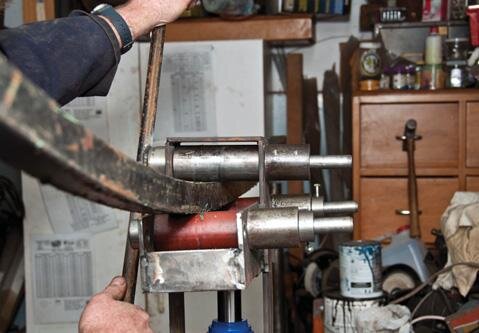A TON OF STEEL BARS MAKE A GREAT WROUGHT-IRON GATE
By Roger Lacey
Kim Nielsen’s dream is to one day own a lifestyle block in the country. While buying the land may be a little way off, it hasn’t stopped him making a gate for the driveway.
Once, while browsing through an old wrought-iron design catalogue, Kim (the son of blacksmiths Ian Nielsen & Son) came across a peacock design and decided it would make a great after-hours project. It turned into a much bigger job than he anticipated with the finished 3 metre by 2 metre gate taking around a ton of steel and about three months to make.
Kim started by making a small demonstration piece to give himself an idea of how it would look before taking the design to a specialist copy shop. The shop blew the design up to full size so Kim could lay it on the floor as a pattern.
Using 40 mm-wide steel, he built the gate in sections, fabricating the intricate peacock body from “U”-shaped pieces, bent in the forge and then welded together. The tail feathers were bent to fit the pattern then the scrolls were added.
Tapering a bar by heating…
…and hammering with a power hammer.
Bending the tip on the anvil
Extra feathers
Scaling up the original design meant that small spaces in the pattern suddenly became big enough for a dog to fit through so Kim had to add many extra feathers to fill in the gaps. Using 12, 14 and 16 mm thick steel, there are a total of 204 hand-forged scrolls in the gate.
“Some companies have scroll-making machines, but these are all hand-made,” Kim says.
To hand-forge a scroll, the flat bar is first tapered by heating and hammering then the end is trimmed by either hot-cutting or grinding. Kim starts the scroll by bending the tip on the anvil before putting it into a hand-operated machine that was originally used for putting the eyes on leaf springs.
With the tight part of the scroll done, the bar is heated again and the eye quenched before it is slipped over a jig to form the gentle part of the curve. Making the feathers individually allowed Kim to weld and finish them before they were all joined together, saving a lot of time and fiddly work at the end.
Once the gate was tacked together on the floor it needed to be turned over to weld and finish the other side. A major effort was required to lift and manoeuvre the ton of steel through the cramped workshop and Kim ended up having to do most of the finishing work outside.
Harnessing the grunt of a machine originally used for putting the eyes on leaf springs…
…to make a scroll.
Quenching the eye
Finishing touches
The roots of all the welds were painstakingly ground to a smooth radius. “It was the hardest part of the job—I killed two disc grinders and my father’s 40-year-old electric die grinder,” he says with a grin. “Dad still hasn’t forgiven me!”
With the gate as yet unpainted Kim hasn’t decided how to finish it. He’s looking at possibly powder-coating or painting it with a Hammerite- type product.
Without a driveway of his own, the problem of what to do with such a large piece has been solved for the time being by hanging it in the entrance of their smithy in Penrose, Auckland. Welded to a 50 mm x 50 mm post and supported by bronze bearings, the ease with which it can be moved belies its weight.
With the gate all but finished, Kim is now working on a design for the gateposts and you can be sure they will be equally spectacular.
On the jig
The prototype
The design at full size—extra scrolls had to be added

